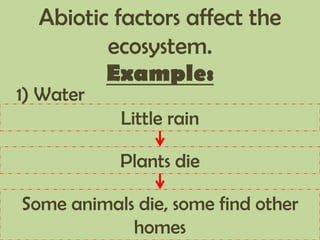Describe Two Specific Abiotic Factors That Influence This Ecosystem
Up to 24 cash back Abiotic Factors - Gobi desert. Yearly the gobi desert receives only 76 inches of rainfall.

1 How Biotic Abiotic Factors Influence The Biosphere Ecosystem 2 What Impact Biotic Abiotic Factors Have On Biodiversity Ppt Download
The values of the abiotic factors in an ecosystem.

. For each of these types of deserts explain why. In part b students were asked to apply their knowledge of various soil horizons and identify a specific biotic and an abiotic component of the A horizon. Ecologists use biotic and abiotic factors to predict population changes.
While winters can be as cold as -40 degrees. The biotic factors that affect deserts include all of the living organisms in the habitat while the abiotic factors that affect deserts include all of the non-living components of the desert. Affect the range of species that are found.
These limiting factors can be further broken down into abiotic or biotic limiting factors. -influences the distribution of some plant species in the ecosystem eg Only those with salt tolerant tissues grow in saline areas eg Mangroves vii Topography -influences the growth of plants ie plants in the leeward side have stunted growth while plants on. Biotic factors are living or once-living organisms in the ecosystem such as food disease competition and predators.
Typical biotic factors of deserts include plants such as drought-resistant grasses cacti aloe plants and other succulents and common abiotic factors of deserts include the soil. Abiotic factors have the potential to affect all living organisms with respect to their growth reproduction and survival. Degradation and soil quality.
It can also have positive effect on organisms. Describe two adaptations of the Gelada Baboon. For example if a plant is adapted to low temperatures and the specific are where it lives has a change in its temperature thanks to global warming this plant will die and this area will no longer support life which is due to the change in abiotic factor temperature.
Also a deficit or abundance of either component can limit other factors and influence an organisms. Abiotic factors are non-living physical and chemical elements in the ecosystem such as sunlight temperature soil water and oxygen. In part a s tudents were asked to describe two climate factors that could affect the rate of soil formation.
Abiotic factors are non living things that affect biotic factors for an example plants need water and sunlight to live which are abiotic factors. These factors are also known as biotic factors and abiotic factors of ecosystem. The abiotic factors in an ecosystem are as follows.
In part c students were. Precipitation which is a significant abiotic factor in a non-aquatic ecosystem can range between 98 and 177 inches annually in a tropical rainforest. Rocks that created the highlands Planet Earth Mountain.
Biotic factors are the living parts of the ecosystem such as plants animals and bacteria. Abiotic factors are the non-living components of the ecosystem including sunlight water temperature wind and nutrients. These include factors such as wind water sunlight soil temperature and humidity.
-lack of plants is a limiting factor for consumers and decomposers. Examples of abiotic factors include. But wind increases the rate of transpiration and therefore water loss.
List three abiotic factors that influence the Ethiopian Highland ecosystem. The average temperature must be greater than 75 degrees Fahrenheit the annual rainfall must be more. -precipitation is infrequent and unpredictable.
Our environment is made up of many living and non-living factors like animals plants soil climate and temperature. Abiotic factors are all of the non-living things in an ecosystem. For example due to different reasons like water pollution.
Wind can cause mechanical damage to. Planet Earth Video Questions. These physical and organic components that are biotic and abiotic factors of the environment interact with each other and form a balanced ecosystem.
Both biotic and abiotic factors are related to each other in an ecosystem and. Higher salinity concentration of salt in the water Ocean currents Water depth Pollution Rocks. Wind can increase the supply of carbon dioxide to plants.
During the summers it can be up to 40 degrees celsius. Abiotic factors are the nonliving parts of the environment such as air minerals temperature and sunlight. Describe the conditions that are true of all deserts.
Up to 24 cash back IcebergsIce -These abiotic factos can pose obstruction to swimming in the Arctic Ocean but can become a safe haven for prey trying to escape the grasp of a water-bound predator like the orca and allow other organisms like polar bears to hunt and a place to live. -lack of water is a limiting factor for plant growth. Several abiotic factors are considered in categorizing an ecosystem as a tropical rainforest.
The temperatures in the Gobi Desert Vary. Organisms require both biotic and abiotic factors to survive. Water -Water is one the most important abiotic factors in the Arctic Ocean.
Marine ecosystems like the oceans rely on these abiotic factors. Abiotic factors can either be non-living chemical and physical parts of the environment.

Classifying Something As Biotic Or Abiotic Lessons Tes Abiotic Biotic Biology Resources

What Factors Influence Ecosystems

1 How Biotic Abiotic Factors Influence The Biosphere Ecosystem 2 What Impact Biotic Abiotic Factors Have On Biodiversity Ppt Download
No comments for "Describe Two Specific Abiotic Factors That Influence This Ecosystem"
Post a Comment